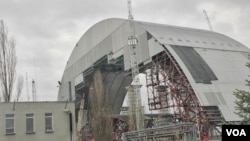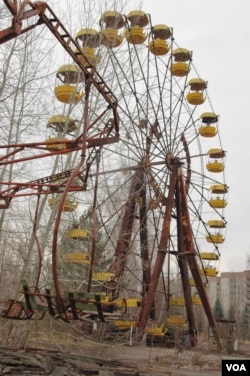Thirty years ago, the world's worst nuclear accident unfolded after an explosion and fire at the Chernobyl Nuclear Power Plant on April 26, 1986.
A look at the scope of the disaster:
What happened: During a shutdown test a steam explosion blew the roof off reactor 4. Blocks of super-heated graphite rained down on the site and huge amounts of radioactive particles were released into the air. Human error and poor reactor design have been blamed.
Where: The nuclear plant is located about 130 kilometers (81 miles) north of Kyiv, Ukraine, and about 20 kilometers (12 miles) south of the border with Belarus.
Deaths: Two workers died immediately after the explosion from non-radiological causes, 29 other workers and firemen died within months from acute radiation sickness. It is estimated thousands more have died from cancers and other illnesses in the ensuing years.
Eventual death toll: Subject to speculation and dispute, the World Health Organization's cancer research arm predicted 9,000 people will die due to Chernobyl-related cancer and leukemia. The Greenpeace environmental group said the eventual Chernobyl death toll could be 90,000.
Accident acknowledged: It took two days before the world knew anything of the blast. Workers at a Swedish nuclear plant first detected fallout. The state-controlled Soviet news media waited three days to acknowledge the accident, and then downplayed its severity.
Emergency actions: Those responding to the accident used helicopters to pour on the reactor debris sand -- to stop the fire -- and boron -- to prevent additional nuclear reactions. The Soviet government also cut down and buried about a square kilometer of pine forest near the plant to reduce radioactive contamination.
"Liquidators": Nearly 600,000 civilian and military personnel from across the former Soviet Union who were sent in to fight the fire and clean up the worst of the nuclear contamination. All were exposed to elevated radiation levels, WHO said.
Zone of Alienation: A 4,762-square-kilometer (1,838-square-mile) tract around the plant where no one is supposed to live. The area is considered unsafe for at least the next century.
Resettlement: As many as 350,000 people from around the plant.
Pripyat: Included in the resettlement figure, more than 45,000 residents of this town, which was built 4 kilometers away from the plant for nuclear workers and their families. Opened in 1970, it was a model of the Soviet ideal -- orderly blocks of soaring apartment towers with a large plaza as its focal point. Today, it sits desolate except for occasional tour groups.
Iconic image: A rusting Ferris wheel in Pripyat that was to start taking paying customers a few days after the blast.
Uranium: More than 200 tons of uranium remain inside the reactor site, fueling fears new radiation leaks could occur.
"Sarcophagus": The concrete-and-steel covering that was hastily built over the reactor to keep radioactive waste from escaping into the atmosphere. Concerns are rising as the sarcophagus nears the end of its three-decade life span.
New Safe Confinement: The internationally funded $2.3 billion project that will build a long-term shelter over the building containing the plant's reactor. The shelter, which resembles a 30-story tall Quonset hut, is a replacement for the "sarcophagus."
Robotics: After long-term shelter is built, robotic machinery inside the structure will begin dismantling the sarcophagus and the destroyed reactor. This stage is expected to begin in 2017.
Present-day workers: 7,000, working on decommissioning the site. The large workforce helps to limit each worker's individual exposure to radiation.
Ukraine nuclear power: The four reactors at the nuclear plant were designed and built during the 1970s and 1980s. Chernobyl's three other reactors were restarted after the explosion and fire, but all eventually were shut down for good, with the last reactor closing in 1999.
Sources: AP, Reuters, U.S. Nuclear Regulatory Commission, Live Science website
















